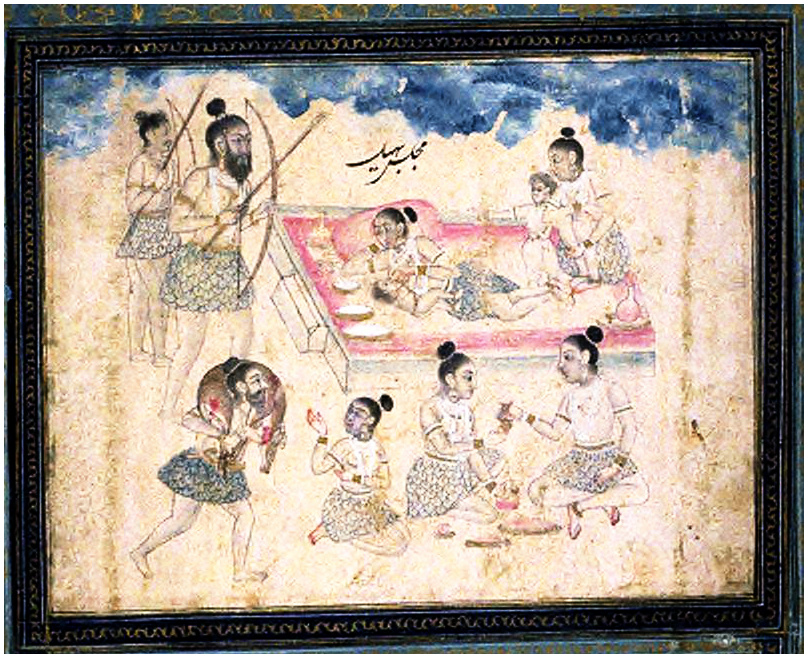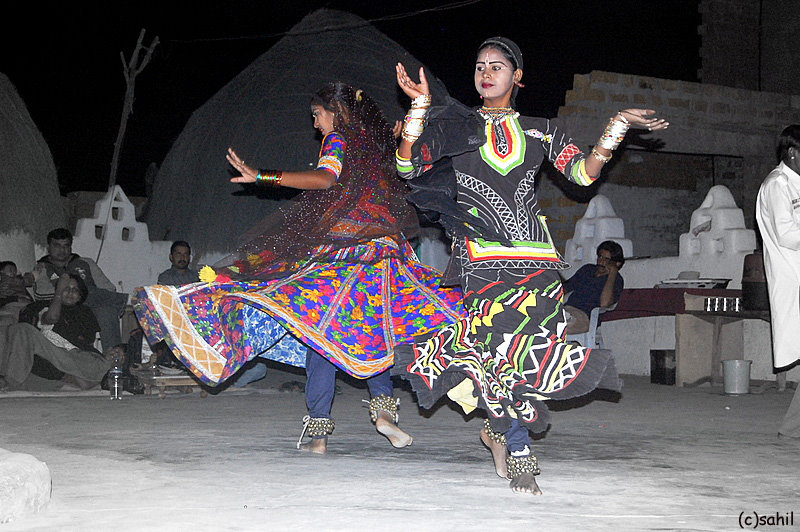|
Ghoomar
Ghoomar or ghumar is a traditional folk dance of Rajasthan. It was the Bhil tribe who performed it to worship Goddess Sarasvati which was later embraced by other Rajasthani communities. The dance is chiefly performed by veiled women who wear flowing dresses called ''ghaghara''. The dance typically involves performers pirouetting while moving in and out of a wide circle. The word ''ghoomna'' describes the twirling movement of the dancers and is the basis of the word ''ghoomar''. According to the traditional rituals, newly married bride is expected to dance ghoomar on being welcomed to her new marital home. Ghoomar is often performed on special occasions, such as at weddings, festivals and religious occasions. which sometimes lasts for hours. 'Gangaur Ghoomar Dance Academy' was established by Maharani Rajmata Goverdhan Kumari of Santrampur in 1986, to preserve and promote ghoomar folk dance. The Government of India awarded her the fourth highest civilian honour of the Padma Shr ... [...More Info...] [...Related Items...] OR: [Wikipedia] [Google] [Baidu] |
Ghoomar (song)
"Ghoomar" ( hi, घूमर) is a song sung by Shreya Ghoshal and Swaroop Khan from the film ''Padmaavat'' (earlier ''Padmavati'') 2018. The music of the song was composed by Sanjay Leela Bhansali while the lyrics were provided by A. M. Turaz and Swaroop Khan. The music video of the track features Deepika Padukone, Shahid Kapoor and Anupriya Goenka. The movie is dubbed in Tamil and Telugu and hence the song was also released as "Goomar" in Tamil and "Jhoommani Jhoommani Aade" in Telugu. The Tamil and Telugu versions as well were sung by Ghoshal while the Kannada version was sung by Darshan N and Sparsha RK. Development On 12 July 2016, Shreya Ghoshal recorded "Ghoomar" which was mixed and mastered by Tanay Gajjar at Wow & Flutter Studio in Mumbai. Ghoshal considered the track as a "landmark" in her career. The music video of the track features Deepika Padukone, Shahid Kapoor and Anupriya Goenka. Padukone had undergone training with a Rajasthani dance teacher Jyoti D Tommar, ... [...More Info...] [...Related Items...] OR: [Wikipedia] [Google] [Baidu] |
Govardan Kumari
Govardhan Kumari (popularly known as Rajmata sa, July 23, 1938 — January 9, 2013), is the only lady from the Royal Family known for her efforts to revive and promote the authentic style of Ghoomar, a folk dance form of Rajasthan. Biography Govardhan Kumari heads the ''Gangaur Ghoomar Dance Academy '', a Mumbai-based dance institution. Under the aegis of the academy, she has contributed to the participation of the students at various dance and cultural festivals, including the festival of ICCR in countries including USSR, Mauritius, Ghana, Nigeria, Morocco, Ivory Coast, Trinidad Tobago, USA, Venezuela, UAE, Oman, ''Doha 2010, the Capital of Arab Culture'', held at Qatar National Theater in September 2010. She made efforts to revive the Rajwadi tradition of Ghoomar dance and in popularizing Chari Dance of Kishangarh. The Government of India awarded her the fourth highest civilian Honour of the Padma Shri, in 2007, for her contributions to arts. The Gangaur Ghoomar Dance Acad ... [...More Info...] [...Related Items...] OR: [Wikipedia] [Google] [Baidu] |
Ghoonghat
A ghoonghat (''ghunghat'', ''ghunghta'', ''ghomta'', ''orhni'', odani, ''laaj'', ''chunari'', ''jhund'', ''kundh'') is a headcovering or headscarf, worn primarily in the Indian subcontinent, by some married Hindu, Jain, and Sikh women to cover their heads, and often their faces. Generally ''aanchal'' or ''pallu'', the loose end of a sari is pulled over the head and face to act as a ghoonghat. A ''dupatta'' (long scarf) is also commonly used as a ghoongat. Since the ancient period of India, the veiling of women (what became known as ghoonghat) has been practiced. Today, facial veiling by Hindu women as part of everyday attire is now mostly limited to the Hindi Belt region of India, particularly Haryana, Uttarakhand, Rajasthan, Himachal Pradesh, Delhi, Uttar Pradesh, Madhya Pradesh, Gujarat, Bihar, and some parts of Sindh and Punjab. It has been both romanticized and criticized in religious and folk literature. Etymology The word ''ghoongat'', ''ghunghat'' or ''ghunghta'' i ... [...More Info...] [...Related Items...] OR: [Wikipedia] [Google] [Baidu] |
Veena Music
Veena Music (Oriental Audio Visual Electronics) is a music label based in Rajasthan, India. It is owned by K. C. Maloo and is headquartered at Jaipur. Since its establishment, it has released many albums in Rajasthani and Hindi languages. and has also acquired music rights of many Rajasthani films. Its main aim is to promote true Rajasthani music in today's music scenario of adulterated, poor and high-noise music. It was established 25 years ago, and has since been a pioneer in fostering Rajasthani music through its albums and various cultural programmes held across the state and abroad. It is a highly successful and well-known music label in Rajasthan. Many regional and non-regional artists are associated with the label which includes regional artists Seema Mishra, Deepali, Supriya and O. P. Vyas while non-regional singers include Shreya Ghoshal, Sunidhi Chauhan, Kavita Krishnamurthy, Udit Narayan and Sadhana Sargam etc. As of March 2016, the label is also a member of Phonograph ... [...More Info...] [...Related Items...] OR: [Wikipedia] [Google] [Baidu] |
Rajasthan
Rajasthan (; lit. 'Land of Kings') is a state in northern India. It covers or 10.4 per cent of India's total geographical area. It is the largest Indian state by area and the seventh largest by population. It is on India's northwestern side, where it comprises most of the wide and inhospitable Thar Desert (also known as the Great Indian Desert) and shares a border with the Pakistani provinces of Punjab to the northwest and Sindh to the west, along the Sutlej- Indus River valley. It is bordered by five other Indian states: Punjab to the north; Haryana and Uttar Pradesh to the northeast; Madhya Pradesh to the southeast; and Gujarat to the southwest. Its geographical location is 23.3 to 30.12 North latitude and 69.30 to 78.17 East longitude, with the Tropic of Cancer passing through its southernmost tip. Its major features include the ruins of the Indus Valley civilisation at Kalibangan and Balathal, the Dilwara Temples, a Jain pilgrimage site at Rajasthan's only hi ... [...More Info...] [...Related Items...] OR: [Wikipedia] [Google] [Baidu] |
Bhil People
Bhil or Bheel is an ethnic group in western India. They speak the Bhil languages, a subgroup of the Western Zone of the Indo-Aryan languages. As of 2013, Bhils were the largest tribal group in India. Bhils are listed as tribal people of the states of Gujarat, Madhya Pradesh, Chhattisgarh, Maharashtra and Rajasthan—all in the western Deccan regions and central India—as well as in Tripura in far-eastern India, on the border with Bangladesh. Bhils are divided into a number of endogamous territorial divisions, which in turn have a number of clans and lineages. Many Bhils now speak the dominant later language of the region they reside in, such as Marathi, Gujarati or a Bhili language dialect. Etymology Some scholars suggest that the term Bhil is derived from the word ''billa'' or ''billu'' which means bow in the Dravidian lexis. The term Bhil is used to refer to "various ethnic communities" living in the forests and hills of Rajasthan's southern parts and surrounding regio ... [...More Info...] [...Related Items...] OR: [Wikipedia] [Google] [Baidu] |
Kalbelia
The Kalbelia are a snake charming tribe from the Thar Desert in Rajasthan, India. The dance is an integral part of their culture and performed by men and women. Kalbelia tribe Kalbelias are followers of Sage Kanifnath, who drank a bowl of poison and was blessed with control over venomous snakes and animals. Kalbelias are divided in two main groups, the Daliwal and Mewara. The Kalbelias moved frequently from one place to another in ancient times. Their traditional occupation is catching snakes and trading snake venom. They rear snakes, dogs, hens, horses, donkeys, pigs and goats. Hence, the dance movements and the costumes of their community bear a resemblance to those of the serpents. They are also called Sapera and Jogira, Gattiwala and Poogiwara. The largest cluster of the Kalbelias is in Pali district, followed by significant other groups in Ajmer, Chittorgarh and Udaipur district. They live a nomadic life and belong to the scheduled tribes. Traditionally, Kalbelia men ca ... [...More Info...] [...Related Items...] OR: [Wikipedia] [Google] [Baidu] |
Culture Of Rajasthan
The culture of Rajasthan includes many artistic traditions that reflect the ancient Indian way of life. Rajasthan is also called "Land of Kings". It has many tourist attractions and facilities for tourists. This historical state of India attracts tourists and vacationers with its rich culture, tradition, heritage, and monuments. It also has some wildlife sanctuaries and national parks. More than 70% of Rajasthan is vegetarian, which makes it the most vegetarian state in India. Music and dance The Ghoomar dance from Jodhpur and the Kalbeliya dance of Jaisalmer have gained international recognition. Folk music is a vital part of Rajasthani culture. Bhopa, Chang, Teratali, Ghindar, Kachchigghori, Tejaji, parth dance are examples of traditional Rajasthani culture. Folk songs are commonly ballads which relate heroic deeds and love stories; and religious or devotional songs known as bhajans and banis (often accompanied by musical instruments like dholak, sitar, sarangi etc.) are ... [...More Info...] [...Related Items...] OR: [Wikipedia] [Google] [Baidu] |
Saraswati
Saraswati ( sa, सरस्वती, ) is the Hindu goddess of knowledge, music, art, speech, wisdom, and learning. She is one of the Tridevi, along with the goddesses Lakshmi and Parvati. The earliest known mention of Saraswati as a goddess is in the Rigveda. She has remained significant as a goddess from the Vedic period through the modern period of Hindu traditions. She is generally shown to have four arms, holding a book, a rosary, a water pot, and a musical instrument called the veena. Each of these items have a symbolic meaning in Hinduism. Some Hindus celebrate the festival of Vasant Panchami (the fifth day of spring, and also known as Saraswati Puja and Saraswati Jayanti in many regions of India) in her honour, and mark the day by helping young children learn how to write the letters of the alphabet on that day. The goddess is also revered by believers of the Jain religion of west and central India, as well as some Buddhist sects. Etymology Saraswati, is ... [...More Info...] [...Related Items...] OR: [Wikipedia] [Google] [Baidu] |
Festivals
A festival is an event ordinarily celebrated by a community and centering on some characteristic aspect or aspects of that community and its religion or cultures. It is often marked as a local or national holiday, Melā, mela, or Muslim holidays, eid. A festival constitutes typical cases of glocalization, as well as the high culture-low culture interrelationship. Next to religion and folklore, a significant origin is agriculture, agricultural. Food is such a vital resource that many festivals are associated with harvest time. Religious commemoration and thanksgiving for good harvests are blended in events that take place in autumn, such as Halloween in the northern hemisphere and Easter in the southern. Festivals often serve to fulfill specific communal purposes, especially in regard to commemoration or thanking to the gods, goddesses or saints: they are called patronal festivals. They may also provide entertainment, which was particularly important to local communities before ... [...More Info...] [...Related Items...] OR: [Wikipedia] [Google] [Baidu] |





